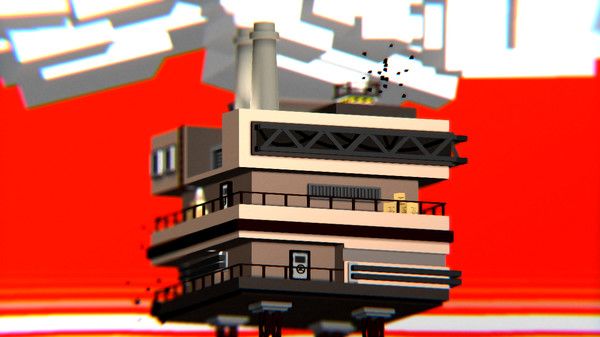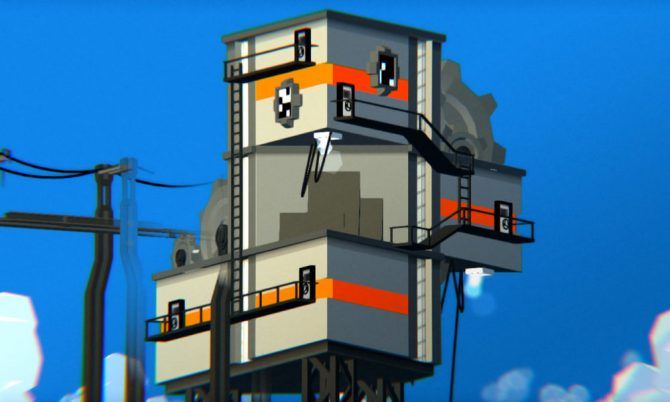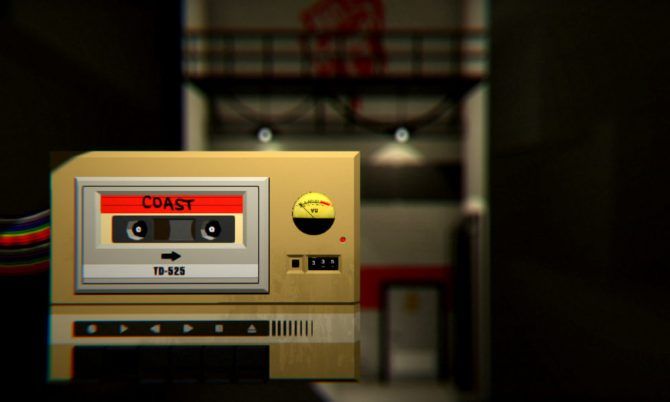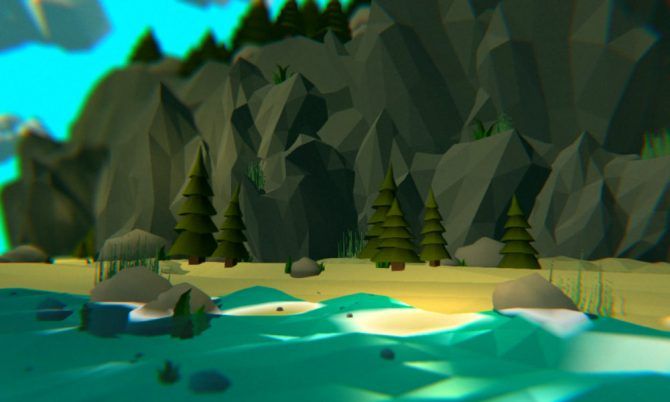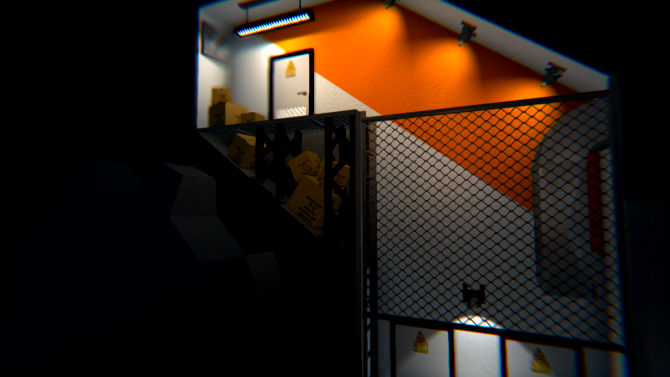Small Radios Big Televisions is a game about exploring digital places stored in analog media. That doesn't sound too exciting, right? Well its not. However, it is perhaps the trippiest, most idiosyncratic game I've played all year. And I play a lot of weird games.
From the moment I hit the glitchy, color-changing title screen all of my senses slowed down -- especially my sight, which became fixated on the screen in a sedative-like stare. After the title screen, Small Radios Big Televisions plops you straight into the game -- no tutorial, no introduction, no easing. The hypnotic nature of the game floods you immediately, and you just start playing.
Everything about Small Radios Big Televisions is relatively simple, allowing you to lose track of what you're doing as you go through the motions. Most of the two-hour experience consists of plunging into abandoned factories thick with a surreptitious vibe. Similar to dioramas, each consists of a simple and sleek design pressed up against decay, such as flooded corridors and graffiti snippets like "Go Back" or "You need to find it." Each factory consists of many entry and exit points that twist around the building, a clever design to make you feel progress as you explore something that ultimately doesn't have much surface area to discover.
However, this design also comes with its problems. Because you don't control a character -- but rather click through the game -- when coming out of a door the camera pans back. Sometimes it's difficult to tell which door you just came out of. The result was me frustratingly re-entering a door I just left several times, which in turn broke me out of the very natural drift the game has. This could have been avoided by better design, or by me being more observant. Either would've worked.
But this game just isn't all factory exploring. Well it is, but there are things to do and find in these factories in order to progress the story. Chief among these things are the pieces of analog media: the cassettes. Every factory holds a small number of "lost" cassettes that can be loaded into your handy-dandy cassette player. When fired up, each cassette transports you to unique virtual world. Further, each comes with a different single word on its face like "MOUNTAINS," "ICE," or "Tundra," and this word as you probably could guess is indicative of the world you will be hurled into. This is where the game really shines.
When I first booted up Small Radios Big Televisions I was a bit enervated and crotchety. It had been a long day, and I had a wicked headache. Within the first minute of playing, I stumbled across the first tape of the game: the "FOREST." What I was greeted by was not just a forest, but one daubed with a lo-fi glitchy glaze. It's aesthetic design shouldn't have been relaxing, but it was.
Accompanied by the subtle but trance-inducing music in the background, I closed my eyes for what felt like an eternity. I opened them back up, refreshed (headache gone), and ready to continue. Each tape has a similar effect, and so I did this quite a few times. It was so good in fact, I started up the game again the next night to just to relax in the "COAST" tape for five to ten minutes. If this game is anything, it's a catharsis exercise.
These virtual worlds aren't just for soaking up the scenery and psychedelic music though. They also house little green orbs that function as keys to doors back in the factories that you will need to open to progress the story. Sense the virtual worlds don't allow for any real-type of exploring, the orbs are always discoverable within 10 seconds and, once clicked-on, transport you back. Further, every cassette can be revisited whenever you want by simply loading it back up.
But wait, it gets better. Each cassette doesn't just contain one of these beautiful virtual worlds: it contains two. Somewhere in each factory there is a wall-mounted magnetic device that takes the cassettes, and distorts and rips apart their worlds. The result are morphed, putrescent versions of the virtual worlds you visited the first time. Life is replaced by decay. Warm colors replaced by cold. The worlds feel corrupted, and unnatural. Yet they still are beautiful and utterly relaxing. That's the true triumph of Small Radios Big Televisions; no matter where it takes you, and what it shows, you are sucked into a state of reverie, and complete peacefulness.
So many shorter games get pacing completely wrong. The end is often far too abrupt, cheaply earned, or the middle of the game doesn't feel hearty enough. Fortunately, Small Radios Big Televisions manages to avoid this hurdle, by cleverly severing up the game into fulfilling bite-size chunks. If Small Radios Big Televisions all took place within one factory it would get monotonous very quickly -- especially since the game's factory environments aren't the richest in detail and design. Luckily, the game takes place over several factory settings that all boast a pinch of distinctiveness. No part of the game feels too short, nor feels too long, which is a very difficult balance to strike for a shorter game.
Also cleverly paced is the slow drip of the game's narrative. After the completion of each factory, the story breaks to a scene of dialogue where a conversation plays over the radio between two unidentified men. The conversation is very often vague, and sometimes frustratingly holds back bits of narrative that would further flesh out the backstory of the game and purpose for what you're doing. But in a game where the allure of mystery is the most compelling argument for you to continue to play, I understand why perhaps the choice was made to maintain a nebulous narrative.
The few times the game does stumble out of its natural flow was the result of stiff controls, which became irritatingly janky at times. Because the game has simple point-and-click controls this was hardly ever an issue. However, when interacting with a few of the game's puzzles that required a level of preciseness, this was a problem. Normally, I'm pretty tolerate of sub-par controls -- at least with these type of games -- but given the perfect, transfixing flow of Small Radios Big Televisions, this grievance is particularly disappointing.
Beyond that, the game has a completely ineffective map that I opened up once, and never again. Even if it wasn't futile and poorly designed, none of the exploration requires it to be opened in the first place. Everything about the level design feels intentional, and simple to coast through. This is especially refreshing, because there is nothing worst than constantly having to open up a map in an exploration heavy game.
Small Radios Big Televisions never requests too much from its players. All of its puzzle are easy -- even for someone as abysmal at them as myself, it's exploration is straight-forward, and it can be completed in one sitting. Developer Fire Face has also crafted arguably one of the best soundtracks of 2016, and because of that I urge anyone who wants to get the most out of it, to use a decent pair of headphones.
Small Radios Big Televisions is more of an experience than a game -- and that's not a bad thing. Sure, its story leaves something to be desired, and its bungling controls are a tad aggravating, but it's one of the most unique and complete experiences I've had with a game this year.
As someone who has ADD, it's difficult for me to concentrate on a game for even 30 minutes -- yet, Small Radios Big Televisions plucked me out of reality and dropped me into its world for two hours. I never once looked away when playing it -- something that has only happened to me one other time. It was upon that realization, that I knew Fire Face had created something unique and special in an industry deprived of originality.

